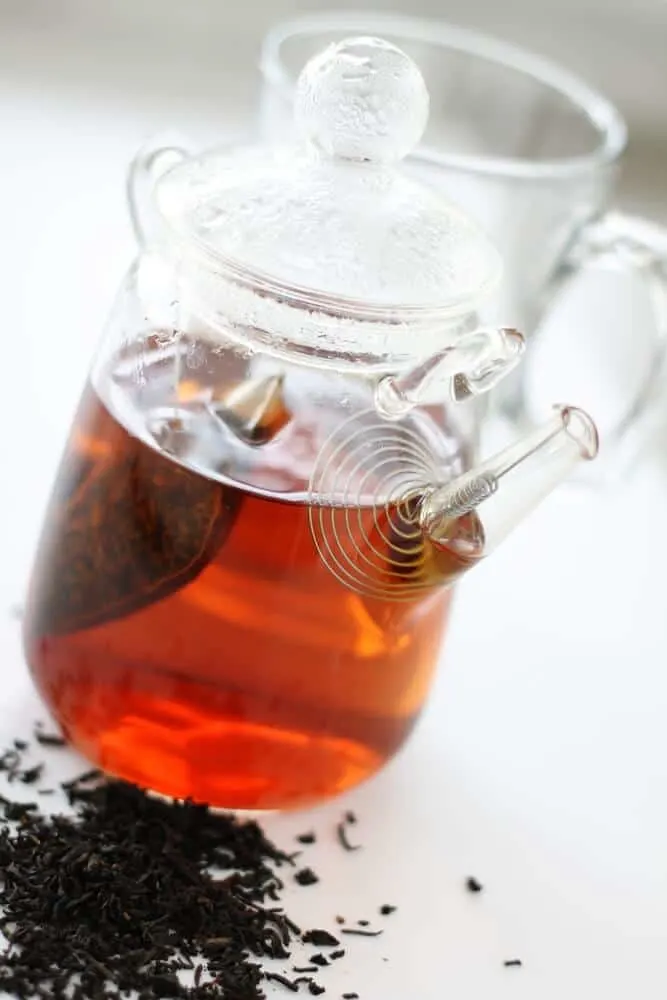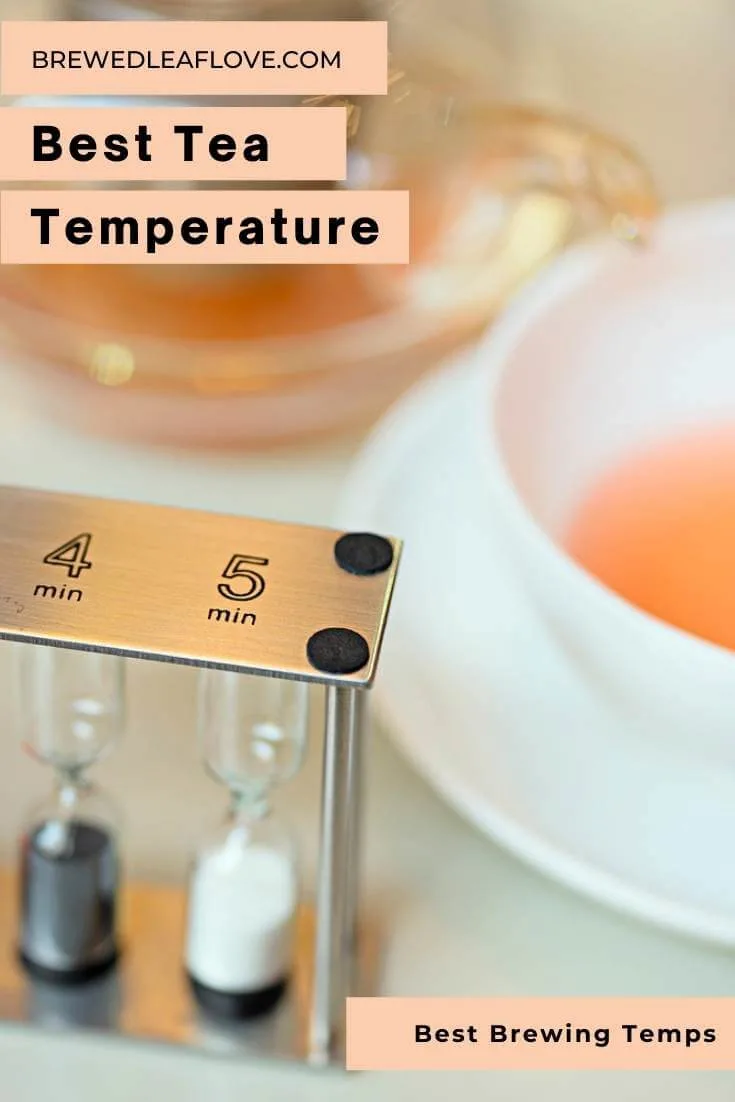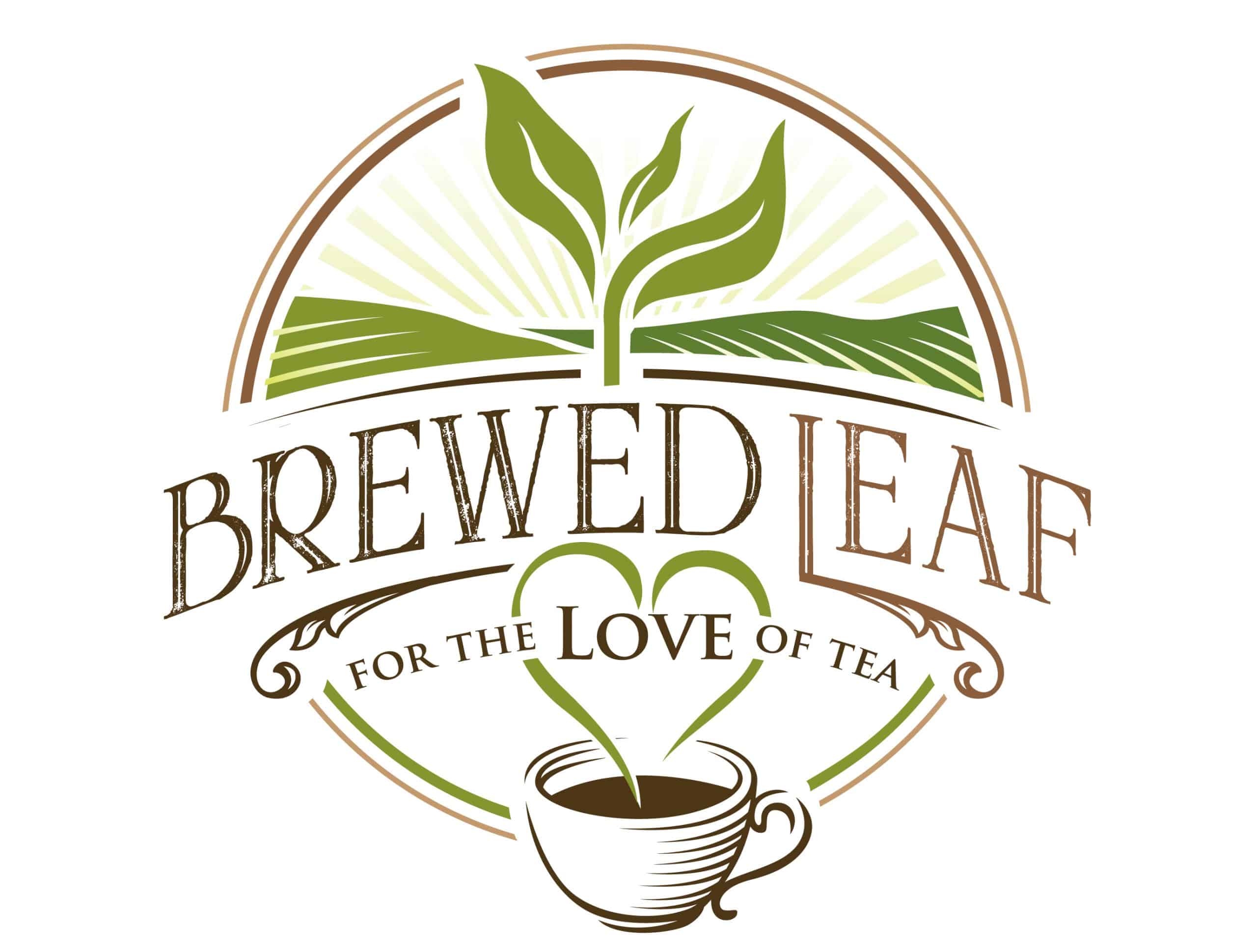When making tea, it can be easy to think that using regular hot water will do the trick. However, tea is pretty sensitive to environmental changes, and extreme or incorrect temperatures can damage the tea leaves and their resulting flavors.
The best temperature for brewing tea depends on the type of tea. Tea should typically be brewed with water between 160 – 200 degrees Fahrenheit. Cold brewing is another option for all tea types. There is ongoing debate on whether boiling water is good or bad for tea leaves.
In this article we will discuss the proper brewing temperatures for different types of tea, as well as the requirements for cold brewing. We will also cover the right types of equipment to use and how temperature affects antioxidant levels.
Brewing Temperature Depends on the Type of Tea
For tea-drinking fanatics, you may already know that there are several differing types of tea. There are two broad categories that can be further broken down into subsets: true teas and herbal infusions. True teas are all derived from the Camellia sinensis plant and include the classic types such as green and black tea.
Though these teas come from the same leaves initially, processing procedures differentiate types from one another.
Herbal teas, unlike true teas, do not all come from the same plant. Instead, they are derived from flowers, roots, herbs, and other plant matter. As a result, herbal teas offer an even wider variety of flavors and aromas, as well as containing equally important health benefits as true teas.
Knowing what type of tea you are using is essential in the brewing process, as each type has slightly different requirements for the right water temperature. While it will not totally ruin a cup or pot of tea by using the incorrect temperature, there are proper heat levels that most effectively extract the flavors and goodness from specific tea types.
Best Temperature for True Teas
As mentioned, true teas are differentiated by different types of processing. Namely, the tea leaves are oxidized for differing amounts of time that results in unique colorings and flavors. This is thanks to the breaking down of compounds throughout the oxidation process.
There are six general types of true teas: white, yellow, green, oolong, black, and pu’erh. We will be covering the overarching brewing standards for each of these types.
It should be noted that yellow tea is somewhat of a rarity if you live outside of China or Japan. Processing tea leaves to achieve yellow tea is a largely forgotten practice, meaning it is mainly only seen within the countries that originally came up with the processing method.
Nonetheless, yellow tea is available for purchase through some online suppliers.
While many teas will have brewing instructions listed on the packaging, it is helpful to know the exact temperatures that work best. The following temperatures listed for each tea type are according to Tea Leaf Journal. In this section, we will also make note of the standard amount of time to steep each type of tea. They are as follows:
- White Tea is processed the least, making the leaves very light in color and producing delicate teas. Thus, the best temperature for brewing is somewhere between 170 – 180 ° Fahrenheit. White teas should be steeped between 2 – 3 minutes.
- Yellow Tea as mentioned is somewhat harder to come by. The brewing standard temperature is 175 ° Fahrenheit. Steeping should be kept relatively short, around 2 minutes.
- Green Tea comes in many varieties, each with differing brewing standards. As a general rule of thumb, the temperature should be kept between 170 – 180 ° Fahrenheit. Green teas should be steeped between 3 – 4 minutes. Both white and Japanese green tea can become overly bitter if left to steep too long, so taste testing after 2 minutes may be a good plan.
- Oolong Tea is a variety of tea that is processed to the midway point between green and black tea. It can generally withstand hotter temperatures, though it should be kept between 185 – 195 ° Fahrenheit. However, oolong teas can also be rolled, which is a method of processing. In this case, they can withstand even hotter temperatures and are recommended to be brewed around the boiling point at 212 degrees Fahrenheit. Steep for between 2 – 4 minutes.
- Black Tea is one of the most oxidized and processed tea types. This makes it able to withstand much hotter temperatures. The rule of thumb is to use almost boiling water between 195 – 205 ° Fahrenheit. If processed in a rolled or pearl form, they may be brewed with boiling water to better extract the flavor. Steep between 4 – 5 minutes.
- Pu-erh Tea can take the highest amount of heat. This is because this tea is very dark and fermented for months or even years. Thus, high temperatures are better at extracting the best flavor from this hearty tea. Use water between 200 – 212 °Fahrenheit, or just at a full boil. Pu-erh tea can be steeped for 3 – 4 minutes.

Best Temperature for Herbal Teas
Because there is such a wide variety of herbal teas, there are many different temperatures to consider when brewing. According to Tea Lovers, most herbal teas can withstand hotter temperatures and can be brewed around the same heat levels as black or Pu’erh teas. Most herbal teas should come with brewing instructions on the packaging.
While most herbal teas can withstand hot temperatures, there are definitely a few that require more specific brewing standards. For instance, Rooibos is an herbal tea made from the leaves of a bush native to South Africa and can be brewed at temperature between 200 – 212 ° Fahrenheit.
Comparatively, another herbal tea called Yerba Mate, made from the stems of the plant of the same name should be brewed at much lower temperatures between 160 – 180 ° Fahrenheit.
According to Simple Loose Leaf, many herbal teas can be steeped for a longer period of time than true teas. However, longer steeping can lead to more bitter brews, so it is highly important to keep an eye on your tea and give occasional taste tests while you are learning which temperatures and steeping times work best for your favorite varieties.
Hot Brewing Tea
When we think about brewing tea, most will think of hot brewing first. This is the most common process of pouring hot water over tea leaves in a teapot and leaving the concoction to steep for 2 – 4 minutes. While it is a relatively simple process, it should still be approached with care and precision. Additionally, there are some factors of hot brewing to keep in mind.
Hot Brewing is Traditional
Tea first came about in ancient China, when tea leaves accidentally fell into boiling water being served to the emperor at the time, according to the UK Tea and Infusions Association. Ancient China set the standards for tea brewing that still hold true to modern-day.
Thus, using hot or boiling water is considered the more traditional manner of drinking and preparing tea.
Hot brewing tea has also made the drink a direct competitor with coffee, with popularity of tea still growing in western nations. In places such as China and Japan, hot tea is served multiple times throughout the day and with most meals. This is largely due to tea’s health benefits that aid in digestion.
Is Boiling Water Good For Tea
After reading the recommended temperatures for brewing in the previous section, you may have noticed that most sit below the boiling point of water. In fact, it is still debated to this day on whether or not fully boiling water is good or bad for tea.
Some argue that water at a rolling boil is too hot for the leaves to handle and ultimately degrades the quality of the tea by burning the leaves and breaking down compounds within them.
However, others argue that the differences in the flavor and quality of brews according to temperature is insignificant. An article published on World Tea News states that the belief that boiling water dilutes the tea of oxygen making the tea dull or flat is a complete myth.
It is generally accepted that lighter teas, such as white and green tea, or floral based herbal teas like Chamomile tea taste better and less bitter when brewed with lower water temperatures. Ultimately, it will come down to personal preference of how each individual likes to prepare their tea according to their own tastes.
While it is best practice to follow guidelines provided by tea manufacturers for brewing, there’s no harm in experimenting to find out exactly what you like.
Health Risks of Hot Tea
There has been some research into the health risks of drinking super-hot tea. According to WebMD, research has suggested that people who drink tea at temperatures hotter than 140 ° Fahrenheit in excessive and consistent amounts may have a higher risk of developing esophageal cancer.
However, critiques of this study and other research have arisen to point out that these studies fail to account for other factors that contribute to a person’s risk of developing cancer, according to an article published on Cancer Research UK.
Nonetheless, the research still suggests that drinking tea at too hot of a temperature poses a risk of damaging and burning cells, leading to inflammation that increases cancer risk. For best safety practices, it is important to let your tea cool down from the peak of its heat at which it is steeped before drinking.

Cold Brewing
Hot brewing is not the only method of preparing tea. In fact, cold brewing tea is growing more in popularity. The method of cold brewing involved placing loose leaf tea or tea bags in a pitcher of room temperature or cool water and then leaving it to steep over a period of 6 – 12 hours.
While hot water extracts the flavors and aromas of tea leaves within a matter of minutes, cool water takes much longer, hence why it is left to steep for several hours.
As for temperature, there is no specific standard in regards to what temperature the water should be for cold brewing. However, there are some important factors of the environment to keep in mind.
Should Cold Brewing Happen in the Refrigerator?
Cold brew tea is recommended to be left to steep in a temperature-controlled refrigerator, around 40 – 45 ° Fahrenheit. However, some people choose to leave tea out at room temperature. Leaving tea out of the fridge will cause the tea leaves to steep faster, but it also greatly increases the risk of bacteria forming in the room temperature water.
Since cold brew tea is left to steep for multiple hours, it works best to fill a pitcher with room-temperature water, add the tea and then leave the pitcher in the fridge to steep. This will help to avoid any bacteria build up over the course of the several hours required for brewing.
Ice Brewing Tea
Ice brewing is a method seen in both traditional tea-making and modern day tea culture. It involves placing preferably loose leaf tea in a teapot alongside ice cubes, and allowing the ice to melt at room temperature. As the ice melts, the leaves steep in the cold water that results from the melting. Many tea fanatics thoroughly enjoy tea prepared in this way.
However, there is some debate on whether or not the extreme cold of the ice cubes degrades the quality of the tea. Many believe that extreme temperatures, be they hot or cold, are not good for tea leaves and break them down much quicker causing either extreme bitterness or dullness.
Similar to the debate with boiling water, there are tea fans on both sides of the argument. Ice brewing remains a common practice, nonetheless. As with boiling, it comes down to personal experimentation and preference.
Because ice brewing happens in a room-temperature atmosphere, it should not be left for more than 30 minutes and should be consumed shortly thereafter to prevent the growth or build-up of bacteria.
Is Cold Brew Tea Healthier?
While hot brewing is the more traditional method of preparing tea, using room-temperature or cold temperatures to brew tea may actually result in higher levels of nutrients and antioxidants in the drink, according to an article from Bustle.
This is attributed to the fact that hot brewing extracts nutrients from tea leaves very quickly, but also breaks down compounds at a higher rate. Comparatively, the slow steeping process of cold brewing allows for a more gradual extraction of nutrients that does less damage to the leaves.
However, longer steeping periods do also result in more bitter teas. Thus, cold brews left steeped over several hours will likely be significantly more bitter than hot brews steeped over a course of only a couple minutes.
The resulting cold brew bitterness may lead tea drinkers to add sweeteners, potentially negating the extra health benefit.
Equipment Needed for Cold Brewing Tea
With cold brewing, you really only need a pitcher and a fridge. Or perhaps a teapot and some ice. While this method is simple, it does take longer than the traditional hot brewing method.
Hot Brewing Tea Equipment
If you want to hot brew your tea at specific temperatures, you are likely going to need a few pieces of equipment to assist you in your brewing adventures. With any equipment, there will be a range of choices and price points for you to choose from.
Generally, you do not need the most expensive resources to achieve a well-brewed tea, but rather the knowledge of how to properly prepare specific tea types.
Electric Water Kettles or Thermometers
The most difficult aspect of hot brewing is knowing the temperature of the water is at since different varieties of tea require different temperatures for steeping. Luckily, in today’s market, there are many electric water kettles that tell you exactly how hot the water is.
These are incredibly useful and probably the best way to achieve the correct water temperature. However, they also tend to be higher in price.
Alternatively, you can purchase a thermometer designed to measure the temperature of hot water. This will require more attentiveness on your part, as you will likely need to check the temperature multiple times in order not to accidentally surpass your desired heat level.
Using a thermometer will be significantly less expensive than purchasing a water kettle, but will also require extra effort.
You can also learn to “eyeball” the water as it heats, though this method is notably less precise than using a measurement tool of some kind. However, learning to eyeball water as it approaches the boiling point is completely free, so it may be the preference for some.
Proper Tea Ware
Many people these days pour their hot water directly into the cup over top of the tea leaves. However, a more proper way would be to use a teapot, preferably made from a cast iron or ceramic material.
Teapots help to contain the flavor and aromas of tea, as well as preserving the temperature for longer. Brewing tea in a teapot also allows for more tea to be prepared at one time, rather than making just one cup.
The Takeaway: It All Depends on the Tea
The temperature to brew your tea at fully depends on what type of tea you are using. Lighter teas like white and green tea, or some herbal teas, often require lower temperatures for brewing. Meanwhile, dark tea and the majority of herbal teas require higher temperatures.
The process and brewing method you use ultimately comes down to personal preference. And to me, even tea brewed at the wrong temperature is still tasty!
If you love tea as much as I do, pin this Best Temperature for Tea to your favorite tea-loving Pinterest board and pass it on for others to enjoy! Pinkies up!

